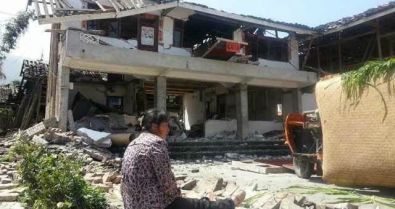


Apr 22, 2012
By Du Yuan (杜远)
Economic Observer Online
Translated by Zhu Na
Original article: [Chinese]
Although the earthquake that rocked Sichuan on Apr 20 was much smaller than the one that hit in 2008, many houses still collapsed near the epicenter of Lushan (芦山) County and in the surrounding counties of Baoxing (宝兴) and Tianquan (天全).
An Economic Observer reporter found through preliminary interviews and investigation that most of the structures that collapsed were old residential houses.
Even before the 2008 Wenchuan earthquake, newly built houses were required to be built to withstand earthquakes based on the most up to date seismic zoning map. These seismic resistance measures are in fact a national requirement for general construction work in China. The map has been amended many times since first implemented in 2001.
According to the map, newly built buildings in Lushan and Baoxing are required to have a “Level 7” earthquake resistance. Hanyuan (汉源) and Shimian (石棉) Counties, which are located to the south of Ya’an city, need “Level 8.” Hospitals and schools in all counties need to be built at a level higher than other buildings in the area.
Public buildings in Lushan and Baoxing including schools and hospitals appear to have escaped the earthquake without totally collapsing, which suggests the national standards played a real role. However, many residential homes did collapse, which was either because they were old or because they were newly constructed, but without the mandated seismic precautions.
In theory, all new rural homes in Lushan and Baoxing should have had earthquake defenses, but in reality, some locals cut corners to save costs. And homes have been scattered very widely, leaving the supervision authority unable to oversee them all.
In addition, the rural areas affected by this earthquake have sent most of their young people out for migrant work, leaving behind mostly elderly people and children, who often also don’t have the money or energy to renovate their homes. And the supervision authority can’t force residents to move out of their old house unless it’s become decrepit.
In recent years, many geological disasters have hit western regions of China. Besides the earthquakes in Sichuan, there have been major mudslides in Chongqing and Gansu that have killed thousands. This reporter has also covered these disasters and spoken with many local officials about possible safety measures.
The most obvious solution is to move out all residents who live in risky areas. But if this was implemented, it would entail re-locating entire towns and counties. The financial costs and the difficulty involved in persuading residents to move make this an unrealistic option.
Another more practical solution would be to gradually move residents scattered throughout mountains and dangerous valleys to towns or counties, and then centralize resources and funding for early warning mechanisms and disaster control.
After covering these disaster-hit regions, one recurring observation by this reporter has been the prevalence of vulnerable elderly people and children, with few young adults. If these counties and towns could develop industry, public services and employment opportunities, it would attract residents of all demographics from mountains and dangerous valleys.
If this happens, then people would leave those regions with frequent geological disasters and they could live together with their whole family in safer urban areas.


